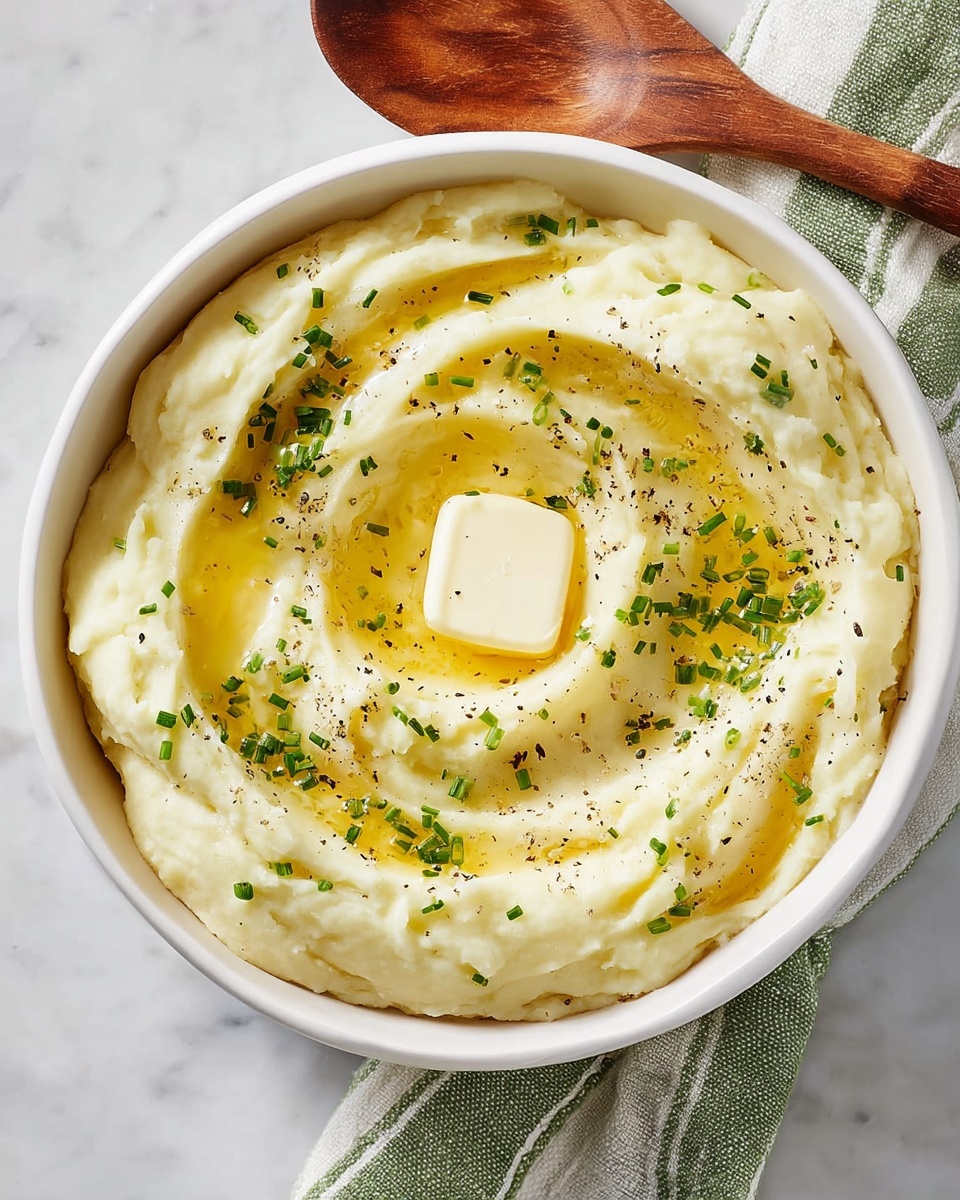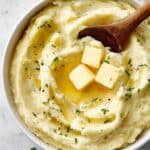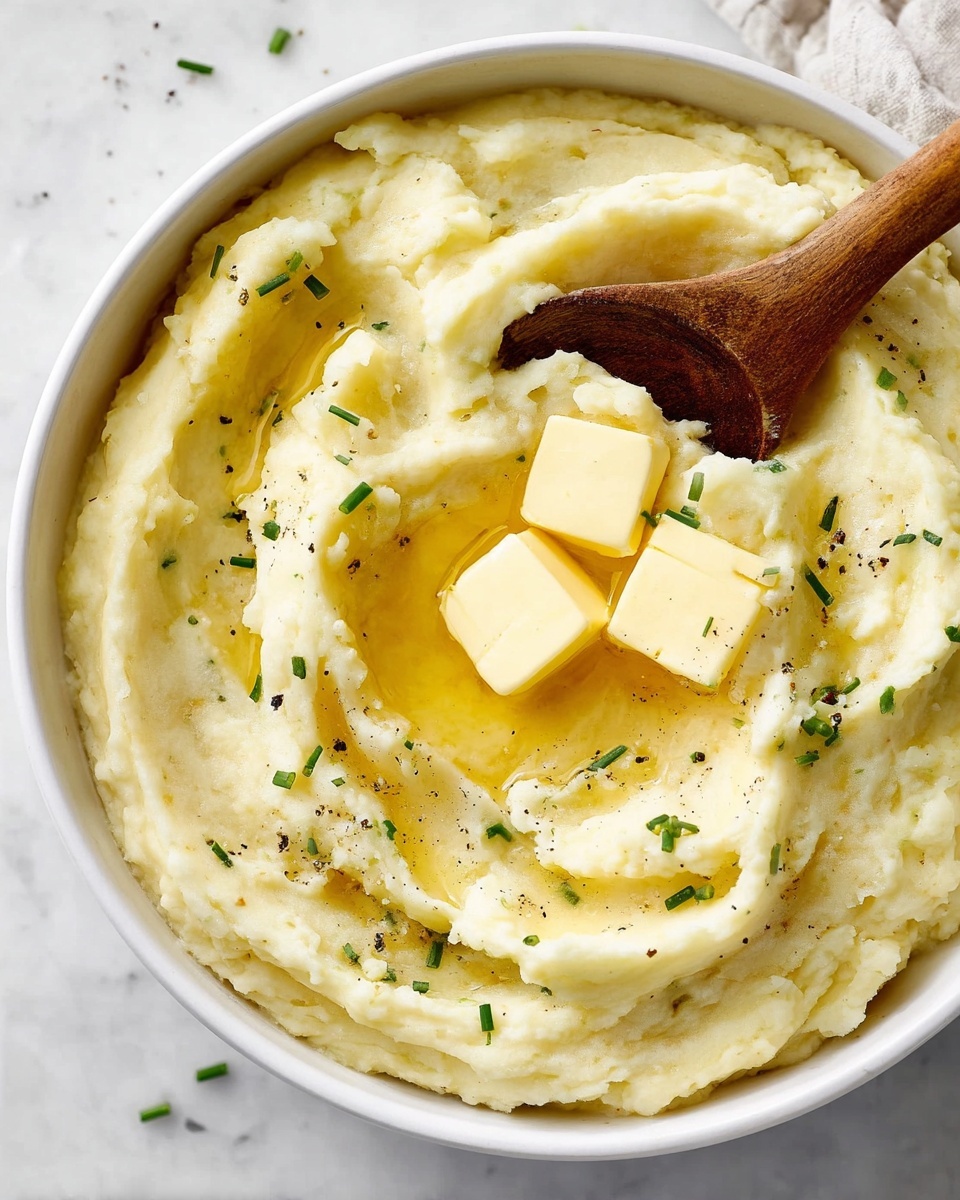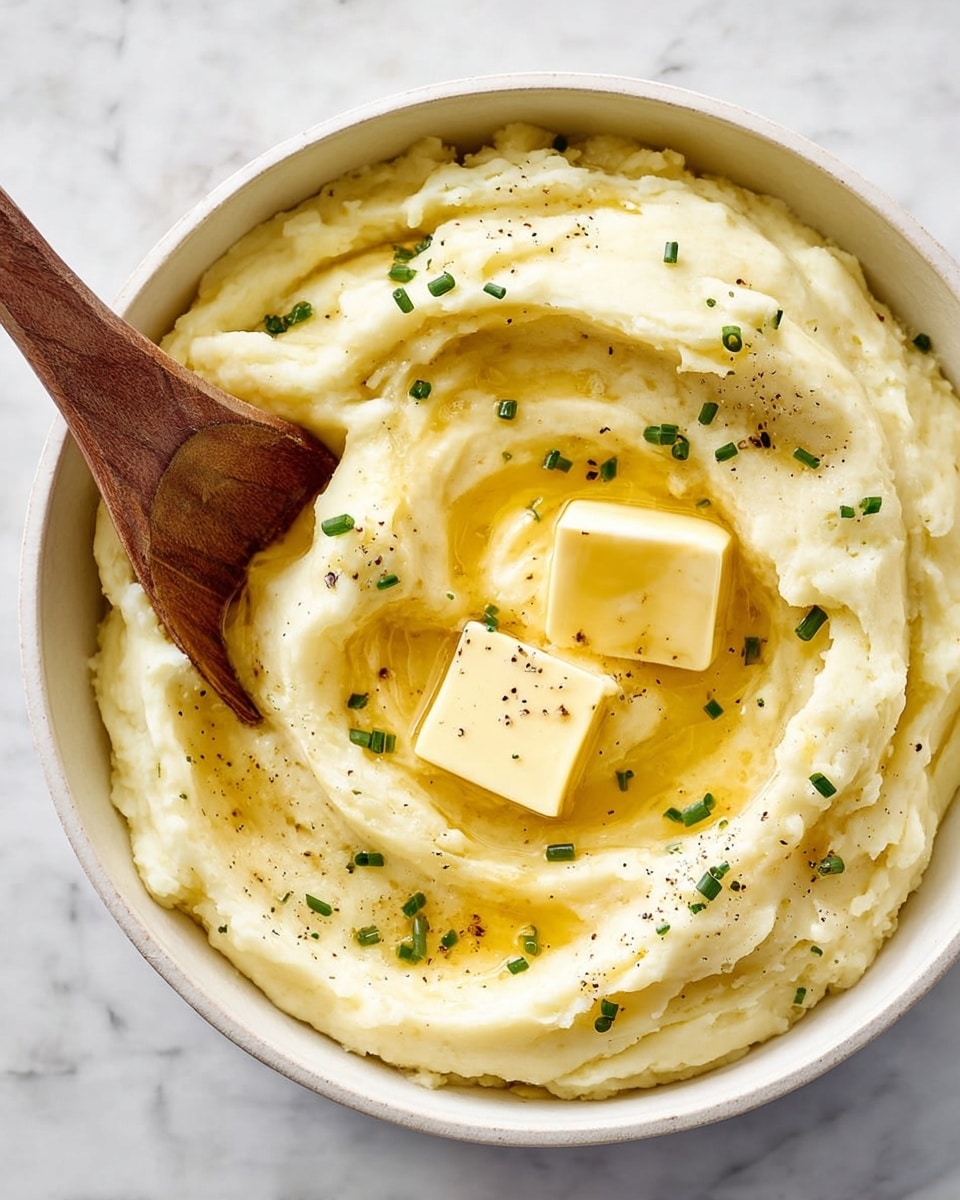If you’ve been on the hunt for the Best Mashed Potatoes Recipe, stop right here—I’m excited to share this one with you! It’s creamy, buttery, with just a hint of garlic that makes every bite sing. Whether you’re making it for a holiday feast or just a cozy weeknight dinner, this recipe hits all the right notes and, honestly, once you try it, you’ll see why it’s my go-to every single time.
Why You’ll Love This Recipe
- Perfectly Creamy Texture: The blend of butter, milk, and optional sour cream creates mashed potatoes that are ultra-smooth and luscious.
- Garlic-Infused Flavor: Cooking the potatoes with garlic adds a subtle yet irresistible aroma and depth, without overpowering the dish.
- Simple Ingredients: Using basic pantry staples that you probably already have makes this recipe easy to whip up anytime.
- Reliable Results: Follow the steps, and you’ll never end up with watery or gluey mashed potatoes again—I promise!
Ingredients You’ll Need
Each ingredient plays a starring role to get the best creamy, flavorful mashed potatoes. I prefer using a mix of russet and Yukon Gold potatoes for the perfect balance of fluffiness and creaminess, but you can adjust based on what’s available. Also, peeling the potatoes ensures that you get truly smooth mash—no surprises!
- Potatoes: Russets give you fluffy texture; Yukon Golds add buttery creaminess—mixing them is my personal hack for the best mash.
- Garlic cloves: Cooking them alongside the potatoes mellows out the raw, sharp flavor into something soft and fragrant.
- Unsalted butter: Using unsalted lets you control saltiness perfectly; plus, lots of butter here for richness is a must.
- Whole milk: I use whole milk for creaminess, but you can experiment with half-and-half or cream if you want extra indulgence.
- Sea salt: Season both the cooking water and the mash itself for well-rounded flavor.
- Freshly ground black pepper: Adds just the right amount of bite and warmth.
- Sour cream (optional): This is my secret weapon for extra tang and richness, but feel free to skip it if you want classic style.
- Chopped fresh chives: For a bright, fresh garnish that cuts through the richness beautifully.
Variations
I love encouraging you to make this recipe your own! Whether you want to boost the flavor or accommodate dietary needs, there are simple swaps and additions you can explore to keep things exciting.
- With cream cheese: I discovered this trick when a friend suggested it—it adds incredible tang and a velvety texture that’s hard to beat.
- Dairy-free option: Swap the butter for olive oil or vegan margarine, and use almond or oat milk instead of dairy milk for a smooth vegan mash.
- Herb-infused mashed potatoes: Mixing in fresh rosemary or thyme (finely chopped) gives it a fragrant twist I adore for fall dinners.
- Spicy kick: If you like a little heat, add a pinch of cayenne or smoked paprika—it wakes up the classic mashed potato beautifully.
How to Make Best Mashed Potatoes Recipe
Step 1: Prep Your Potatoes and Garlic
Start by peeling your potatoes and cutting them into large, even chunks. This size cooks evenly without turning mushy. Toss the potatoes and whole garlic cloves into a big pot and cover with cold water—make sure the water covers them by about an inch. Adding a big pinch of salt to this water seasons your potatoes as they cook, which makes a huge difference in flavor later. I usually bring the pot to a boil over high heat, then turn it down to medium to maintain a gentle boil for about 15-20 minutes. Keep testing them with a fork—you want them fork-tender but not falling apart.
Step 2: Drain and Begin Mashing
Drain all the water off, then put the potatoes and garlic back into the pot while still hot—that’s key for fluffy mashed potatoes. I start mashing with a good old potato masher until the lumps break down. You’ll notice the aroma of the soft garlic mixing in here, and it’s pretty magical. This is the fun part—the moment the potatoes start to look nearly mashed, it’s time to get creamy.
Step 3: Add Butter, Milk, and Seasoning
Now add your butter, warm milk, salt, and a few grinds of fresh pepper. I always warm the milk slightly so it doesn’t chill the potatoes, keeping everything luxuriously smooth and warm. Keep mashing and folding until you get the texture you want—some like theirs a bit chunky, but I aim for totally smooth. If you like, fold in the sour cream at this stage—it’s an optional extra, but I love how it adds just a little tang and richness.
Step 4: Taste and Finish
Give your potatoes a final taste and adjust salt and pepper to your preference. Serve immediately while everything is warm, with a pat of butter melting on top and a sprinkle of chopped fresh chives for color and fresh flavor. Trust me—this simple touch makes all the difference!
Pro Tips for Making Best Mashed Potatoes Recipe
- Use a Potato Ricer or Masher: I used to struggle with lumps until I switched to a good masher; avoid over-processing with a mixer to keep fluffiness.
- Warm Your Dairy: Warming the milk and melting the butter before combining prevents the potatoes from cooling and getting gluey.
- Don’t Overcook the Potatoes: Overboiled potatoes absorb too much water, turning your mash watery—check early to avoid this.
- Drain Thoroughly: Draining well and returning potatoes to the warm pot dries them out a bit and improves texture.
How to Serve Best Mashed Potatoes Recipe

Garnishes
I almost always top these mashed potatoes with a few pats of extra butter for melt-in-your-mouth creaminess, plus a generous sprinkle of fresh chopped chives for a pop of color and fresh bite. Sometimes, I’ll add crispy fried onions or a dusting of smoked paprika for an added flavor boost that my family goes crazy for.
Side Dishes
These mashed potatoes pair wonderfully with classic roasted chicken, holiday turkey, or even a rich beef stew. I’ve also served them alongside sautéed greens or glazed carrots for a colorful, well-rounded meal. Honestly, they’re a crowd-pleaser no matter what you serve!
Creative Ways to Present
For special occasions, I like to pipe these mashed potatoes into pretty swirls or dollops using a piping bag—makes the plate look fancy with minimal effort! Another fun idea is to bake them with a light crust of Parmesan cheese or breadcrumbs on top for a golden, crispy finish that delights guests.
Make Ahead and Storage
Storing Leftovers
When I have leftovers, I store mashed potatoes in an airtight container in the fridge for up to 3 days. They tend to thicken overnight, so I always add a splash of milk or cream when reheating to refresh that creamy texture.
Freezing
I’ve had good luck freezing mashed potatoes in portioned containers. To avoid freezer burn, cover them tightly with plastic wrap before sealing the container. When thawed and reheated, stirring in a bit of butter and milk revives the creamy goodness nicely.
Reheating
Reheat mashed potatoes gently on the stove over low heat or in the microwave in short bursts, stirring frequently. This way you avoid drying out or breaking down the texture. Adding a bit of warm milk or butter during reheating brings them back to their original silky perfection.
FAQs
-
What type of potatoes are best for mashed potatoes?
Russet and Yukon Gold potatoes are the best combo—the russets give you a fluffy texture, while Yukon Golds add buttery creaminess. Feel free to mix them for balanced, perfectly creamy mashed potatoes like in my recipe.
-
Can I make this recipe dairy-free?
Absolutely! Swap the butter for olive oil or a vegan butter alternative, and use unsweetened plant-based milk like almond or oat milk instead of whole milk. You’ll still get creamy, delicious mashed potatoes.
-
Why are my mashed potatoes sometimes watery?
Watery mashed potatoes usually happen if the potatoes absorb too much water during cooking or if you don’t drain them thoroughly. Be sure to cut even chunks, avoid overboiling, and drain well before mashing. Also, don’t add cold milk or butter straight from the fridge.
-
Is it better to peel potatoes before boiling?
Peeling before boiling helps you get super smooth mashed potatoes without any skins getting in the way. Some people boil with skins to retain nutrients, but if you want silky smooth results like my Best Mashed Potatoes Recipe, peeling first is the way to go.
-
Can I make mashed potatoes ahead of time?
You can make mashed potatoes a day ahead and keep them covered in the fridge. When reheating, add a splash of warm milk or butter to restore creaminess. Just avoid making them too far ahead as they’re best fresh but can be frozen and reheated as well.
Final Thoughts
Honestly, the Best Mashed Potatoes Recipe feels like the ultimate comfort food in my kitchen. I love how easy it is, how reliably it turns out creamy and flavorful, and how it never fails to bring everyone around the table. I’m sharing it with you not just because it’s great, but because I want you to have that perfect bowl of mashed potatoes every time you need a little cozy happiness on your plate. Give it a try—you’ll be so glad you did!
Print
Best Mashed Potatoes Recipe
- Prep Time: 15 minutes
- Cook Time: 30 minutes
- Total Time: 45 minutes
- Yield: Serves 8
- Category: Side Dish
- Method: Stovetop
- Cuisine: American
Description
This Best Mashed Potatoes Recipe delivers perfectly smooth, creamy, and flavorful mashed potatoes made with russet or Yukon Gold potatoes, garlic, butter, whole milk, and optional sour cream. It’s a classic comfort side dish, ideal for holidays or any meal requiring a rich and satisfying potato dish. The addition of garlic infuses a subtle savory note, while fresh chives add a vibrant garnish, creating a versatile and crowd-pleasing accompaniment.
Ingredients
Potatoes & Aromatics
- 3 pounds potatoes (russet potatoes, Yukon Golds, or a mix), peeled and cut into large chunks
- 3 garlic cloves
Dairy & Seasoning
- 1/2 cup unsalted butter (1 stick), plus more for serving
- 1 cup whole milk
- 1 1/2 teaspoons sea salt, plus more for the cooking water
- Freshly ground black pepper, to taste
- 1/4 to 1/2 cup sour cream (optional)
Garnish
- Chopped fresh chives
Instructions
- Prepare Potatoes and Garlic: Place the peeled and cut potatoes along with the garlic cloves in a large pot. Cover them with cold water by about 1 inch and season the water with a tablespoon of salt to infuse flavor as they cook.
- Cook Potatoes: Bring the pot of water to a boil over high heat, then reduce heat to medium to maintain a gentle boil. Cook for 15 to 20 minutes or until the potatoes are fork-tender, ensuring they are soft enough to mash easily. Drain the potatoes and garlic well and return them to the pot to remove excess moisture.
- Mash Potatoes: Begin mashing the potatoes and garlic using a potato masher. Once partially mashed, add the unsalted butter, whole milk, 1½ teaspoons sea salt, and freshly ground black pepper. Continue mashing until the potatoes reach your preferred smoothness, aiming for a silky texture.
- Incorporate Sour Cream (Optional): Use a spatula or wooden spoon to gently fold in the sour cream, if using. This adds a creamy tang and extra richness to the mashed potatoes.
- Finish and Serve: Taste and adjust seasoning if needed. Serve the mashed potatoes topped with an extra pat of butter and a sprinkle of chopped fresh chives for color and mild onion flavor. Enjoy warm as a comforting side dish.
Notes
- Use a potato masher for best texture, or a hand mixer for fluffier potatoes.
- Do not overcook potatoes to avoid them becoming watery or gluey.
- Peeling the potatoes before boiling helps in achieving smoother mash but leaving skins on can add texture and nutrients.
- Rinsing cut potatoes before cooking can reduce excess starch and prevent them from becoming gummy.
- Substitute sour cream with cream cheese for a different creamy flavor.
- Covering the pot while boiling can speed up cooking time but watch to prevent boiling over.
- Adjust salt and pepper according to taste preferences.
Nutrition
- Serving Size: 1/8 of recipe (about 3/4 cup)
- Calories: 210
- Sugar: 2g
- Sodium: 420mg
- Fat: 9g
- Saturated Fat: 5.5g
- Unsaturated Fat: 3g
- Trans Fat: 0g
- Carbohydrates: 29g
- Fiber: 3g
- Protein: 4g
- Cholesterol: 25mg




Your email address will not be published. Required fields are marked *